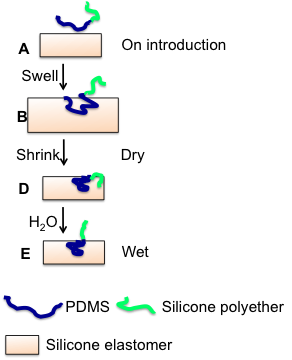Abstract: The simple modification of silicone surfaces by a novel silicone surface treatment agent (n-Wet) leads to long-term wettable, low protein adsorbing surfaces. Water contact angles decreased significantly after treatment: the desired wettability, to less than 20°, is controlled simply by the concentration of n-Wet solution. Fibrinogen absorption was dramatically reduced to <0.1 mg/cm2.
Introducton: Protein fouling of polydimethylsiloxane (PDMS) surfaces often has an adverse impact on the performance of medical biomaterials. Attempts to achieve protein repellant surfaces and improve wettability of the silicone by oxygen plasma treatment [1], surface coating, or grafting of hydrophilic polymers [2],[3] require multiple chemical reaction steps and irrespective, the surfaces rapidly return to their hydrophobic nature. We present a simple method to achieve PDMS elastomer surfaces that remain wettable over extended periods of time and which are much less easily fouled by proteins.
Materials and Methods: Materials: n-Wet was provided by EnRoute Interfaces, Inc. Sylgard 184 silicone elastomer kit was purchased from Dow Corning.
General procedure for flat surface modification: The PDMS elastomer were prepared according to the vendor instructions, and punched into small pieces of about 6 mm diameter and 0.5 mm thick. The PDMS pieces were extracted with CH2Cl2 to remove uncrosslinked components and dried under vacuum before surface modification. The PDMS pieces were soaked in surfactant solution in toluene with a range of concentrations from 0.1-20% w/w for 20 h, then removed from the solution and dried to deswell the elastomer approximately back to its original size. The pieces were rinsed with DI water thoroughly and dried under stream of nitrogen.
Results and Discussion: Wetting behaviors: The novel silicone surfactant, n-Wet, consists of a PDMS anchoring group and a silicone polyether. The key to wettability is the physical immobilization of small quantities of silicone surfactant on the silicone elastomer surface, via partial swelling of the elastomer surface to allow intercalation of one hydrophobic block of the surfactant, followed by de-swelling: a second, smaller block in combination with PEG acts to reduce surface tension (Figure 1). A significant change in contact angle, down to ca. 20°, was observed following modification. An inverse relationship between contact angles and the concentration of applied n-Wet solution was observed. Thus, the surface concentration of the wetting agent can be ‘dialed in’ to reduce, on demand, the sessile water drop contact angle from ~110° to 20° (Figure 2). Unlike other methods, when stored in air after modification, surfaces remained water wettable for up to one year.


Protein adsorption: Fibrinogen was chosen as a model protein for the assay of protein adsorption on n-Wet-modified surfaces. The assay was carried out in a standard manner3. The results are shown in Figure 3. After treatment of a silicone elastomer with only 1% active wetting agent, the amount of fibrinogen absorbed was <0.1 mg/cm2, as measured by radiolabelling, which is dramatically lower than with unmodified silicone.

Conclusion: Permanently water wettable silicone elastomer biomaterials surfaces are readily prepared through absorption of surfactants at the elastomer interface. Protein fouling on these surfaces is dramatically reduced compared to the control silicone surface.
We acknowledge the Natural Sciences and Engineering Research Council of Canada and EnRoute Interfaces for financial support of this research; We are thankful to Prof. Heather Sheardown and Lina Liu for the fibrinogen adsorption assay and valuable scientific discussions
References:
[1] He, Q. G.; Liu, Z. C.; Xiao, P. F.; Liang, R. Q.; He, N. Y.; Lu, Z. H., Preparation of hydrophilic poly(dimethylsiloxane) stamps by plasma-induced grafting, Langmuir 2003, 19(17), 6982-6986.
[2] Rambarran, T.; Gonzaga, F.; Brook, M. A.; Lasowski, F. and Sheardown, H., Amphiphilic Elasto-mers from Metal-Free, Click Crosslinking of PEG-Grafted Silicone Surfactants, J. Polym. Chem. A: Polym. Sci. 2015, 53, 1082–1093.
[3] Chen, H.; Brook, M. A.; Chen, Y. and Sheardown, H., Surface properties of PEO-silicone composites: reducing protein adsorption, J. Biomaterials Sci., Polym. Ed., 2005, 16, 531-548.